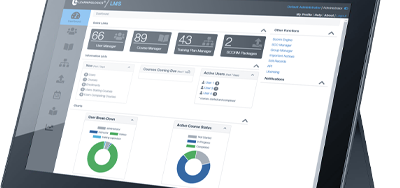
Learning logics
Learninglogics®
Bluedrop’s Training Development and Management System meets the demands of today’s modern training needs.

Bluedrop’s Training Development Management System and management system includes three components which can be used singly or as a comprehensive suite:
The Learninglogics™ Training Document Manager (TDM) is used by Subject Matter Experts (SMEs) to create schemas and document templates such as: Qualification Standards and Plans (QSPs) or Qualification Standards (QSs) and Training Plans (TPs) to support competency and skills documentation. Using section templates and a rich-text HTML editor, users can create, edit, copy and publish their own training documentation.
TDM can be formatted to produce and manage any Course Control Document (CCD), and allows users to create their own templates or use the defaults provided within the module.
TDM can be used on its own or in conjunction with the Learninglogics® Learning Content Management System (LCMS). When used in conjunction with the LCMS, direct links between the CCD and course content can be established. This enables changes made to a CCD, to be highlighted in the corresponding courseware associated in the LCMS.
This link is dynamic, so any change made to the CCD notifies the user that change or review of the courseware is required, thus increasing efficiency of reviews and modifications enabling improved configuration management and sustainment of training materials.
.

Authoring – TDM allows a user to easily develop, edit, copy or link content to create training documents. TDM automates some of the content creation by allowing the SME to develop section templates and sharing assets to create the training and standards necessary to meet the needs of the competency environment. An administrator can customize the templates to meet your document needs before you begin to develop content.
Previewing – TDM’s preview feature allows the developer to view various plans,and objectives before content is development and throughout it’s lifecycle. Though commonly referred to as performance and enabling objectives, level names are user-defined to allow for maximum flexibility in adapting to your training and business practices.
Publishing – Once you have developed your content, you can use the “publish” feature to create a Portable Document Format (PDF) of your training or qualification document.

Bluedrop’s Learninglogics® LCMS is a robust online content management tool that is used to create, store and assemble training content lessons. Learninglogics® lets trainers, Subject Matter Experts (SMEs), courseware developers, or anyone with training content, to easily build state-of-the-art, web-based courses, evaluations and surveys.
Web-based system
Offers a completely web-based system that provides both power and flexibility.
Standards based
Certified to Advanced Distributed Learning’s (ADL’s) Sharable Content Reference Model (SCORM), Extensive Application Programming Interface (xAPI) and Computer Managed Instruction 5 (CMI5) industry standards for e-learning.
Reusable learning objects
Bluedrop’s LCMS architecture, based on reusable “learning objects”, makes it easy for trainers to assemble, reuse and update content.
Automated authoring
Learninglogics® automates the process of content creation by providing trainers with templates based on sound instructional design principles and allows for linking of content for reuse.
Personalized learning
Courses can be customized for individuals or groups of users. Learning objects can be reused to construct multiple versions of courses.
Fully customizable interface
The LCMS interface can be customized to reflect an organization’s desired look and corporate image while supporting variations in learning presentation including self-paced and instructor-led (dual screen) interfaces.
Predefined templates
Choose from a set of predefined screen and questions styles that integrating a range of web-compatible multimedia and interactivity.
Comprehensive evaluations
Trainers can create a wide range of test questions, including multiple choice, drag and drop, and clickable images as well as many others. Tests can be measured evaluations or embedded knowledge checks. Bluedrop’s LCMS also lets trainers produce question banks that can be stored and reused as learning objects in multiple courses.
Media auditing and cataloguing
Learninglogics® has a powerful media auditing capability that allows trainers to track progress of graphic development. This feature also lets courseware developers search for graphics, track usage, and reuse media from a graphics library.
Multimedia integration
Content can include any web-compatible multimedia such as images, webGL, streaming video, 3D objects and simulations.
Glossary
Create a glossary of key terms that can be grouped by category and searched by students from the courseware interface.
Integrated Review Process
Review of created courseware and report on changes made.

The Learninglogics® LMS is a powerful and flexible management system that is ideally suited to the training needs of a wide range of organizations. It is easy to use and can be customized to manage and control any size and type of learning environment. Learninglogics® LMS provides enrolment capabilities, creates and maintains user records, designs and launches e-learning courses, offers records and content keeping, and virtual classroom management.
The Learninglogics® LMS capabilities include:
The student interface allows students to enter, view and modify personal information. Students open web-based course tasks directly from the interface with fully traceable performance results.
The Group Manager lets instructors create and manage groups of users.
The Enrollment function enables enrollment of individual users or groups of users in courses.
The Course Designer is a curriculum-planning tool for outlining and creating course structures.
The Report Manager allows for the review of a range of status and user progress reports.
The Message Centre enables communication about course and administration information with groups of users.
The Training plan feature allows for the organization of course distribution.
